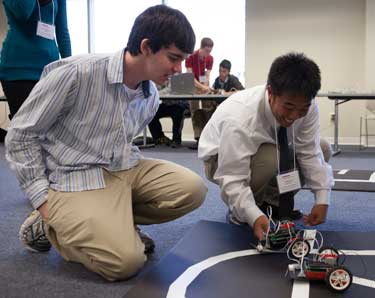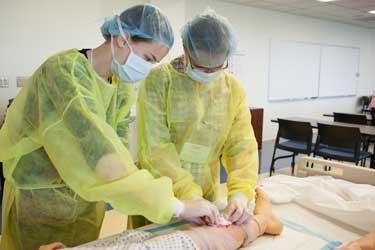A group of students and their teachers huddle in a garage bay with a completely disassembled Toyota Yaris on one side and big-screen LCD monitors and computer equipment on the other. Their task is to analyze accident reports, review crash tests, and learn how computer simulations assess potential injuries to the vehicle occupants. Down the hall another group of students spend the morning integrating mechanical, electrical, and computer software systems through a microcontroller as they design and build their own robots. One floor up, another group of students in a simulation lab learns how technology-enhanced, high-fidelity manikins help train the next generation of nurses and health care providers.
This is not just another day in school for more that 130 select LCPS high school students and teachers. This is what happens when The George Washington University’s Virginia Science and Technology Campus (VSTC), in partnership with Loudoun County Public Schools (LCPS) and Raytheon Corporation, team up at the university’s state-of-the-art campus to expose students to opportunities in the fields of science, technology, engineering, and mathematics (STEM).
During the Sixth Annual Science, Technology, and Engineering Day, students and teachers participated in ten interactive workshops designed to introduce them to new experiences outside of their traditional classrooms. Students also heard from two featured speakers— Raytheon’s Michael Walker, a cyber security expert, and Frank L. Culbertson, Jr., a former NASA astronaut and current senior vice president at Orbital.
Local high school students dress a wound on a high-fidelity manikin in GW's Nursing Skills and Simulation Center during Science, Technology, and Engineering Day. (Photo by Jessica Burt)
“This event provides students hands-on experience with emerging innovations in science, technology and engineering, and exposes them to the excitement these fields offer,” said Ali Eskandarian, dean of the Virginia Science and Technology Campus. “The participation of Raytheon, and GW partners, The JASON Project and the IJIS Institute, provides the students with a real-world context to the day’s lessons.”
The day’s workshops included an array of topics hosted by a variety of groups from the University and its’ partners:
- Bridges, Earthquakes and Tsunamis (GW Civil and Environmental Engineering);
- Car Crashes and Injuries—How Accident Analyses and Computer Simulation is Used to Design Safer Cars (National Crash Analysis Center);
- Crime in the Virtual World—Identification and Protection (IJIS Institute);
- First Responders and Hazardous Materials (Center for Preparedness and Resilience);
- The Future of Energy (GW Mechanical and Aerospace Engineering);
- Greater than the Sum of its Parts: Integrating a Robotic System (GW Mechanical and Aerospace Engineering)
- Herbal Medicinal Compounding (Shenandoah University Bernard J. Dunn School of Pharmacy);
- Mars Rovers, Car Crashes, Deep Sea Diving and Roller Coasters in Your Classroom: Technology and Science Education (The JASON Project);
- The Science of Accident Investigation: NTSB and TWA Flight 800 (The National Transportation Safety Board (NTSB) Training Center); and
- Technology and the World of Nursing (GW School of Nursing).
Full workshop descriptions are available online.
In the morning and afternoon two industry leaders guided the students through a journey of global networks and interstellar exploration. First, Michael Walker, deputy director at Raytheon's SI labs, shared his expertise in cyber security, including security vulnerability assessment, network penetration, and hacking. Walker provided an in-depth, technical discussion that introduced the students to the newest concepts and terminology in cyber security and provided them insights into several career paths with many local opportunities.
With the arrival of the space shuttle Discovery to Dulles Airport only days away, the teachers and students then had a rare opportunity to interact with the keynote speaker, Frank Culbertson Jr. Mr. Culbertson, currently a senior vice president for Orbital Sciences Corporation, is a former International Space Station commander, space shuttle commander and pilot, and NASA manager for the Phase I Shuttle-Mir Program. He spoke candidly about his experiences in space, as well as shared his aviation-based life philosophy—“Navigate. Aviate. Communicate.” These words are critical when you fly any aircraft, but are equally applicable to your life, Culbertson told the group. He also recounted momentous events in his career including his NASA training, the technical details of lift-off, exercising in zero gravity, and how it felt to be the only American off of the planet during the 9/11 attacks. His full presentation is available on YouTube.
“GW's STE day offers our students a tremendous opportunity to discover different STEM fields and the educational and careers paths that lead to them,” said Odette Scovel, Science Supervisor for LCPS, “GW and their partners put a tremendous amount of effort into planning this event each year so that it is fun as well as educational.”



